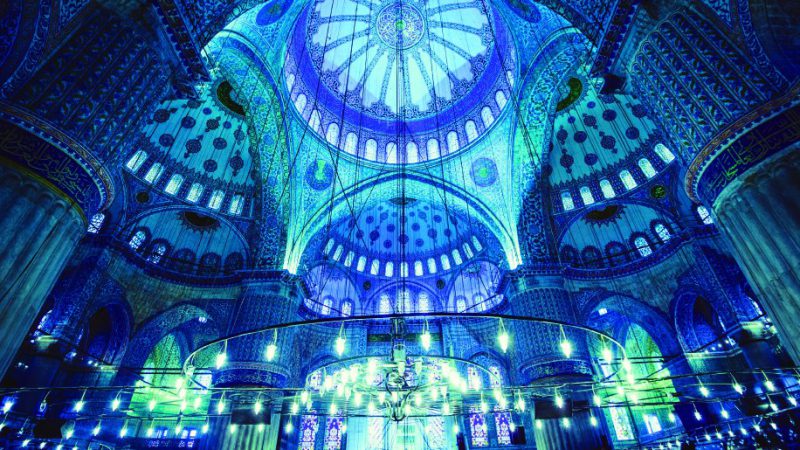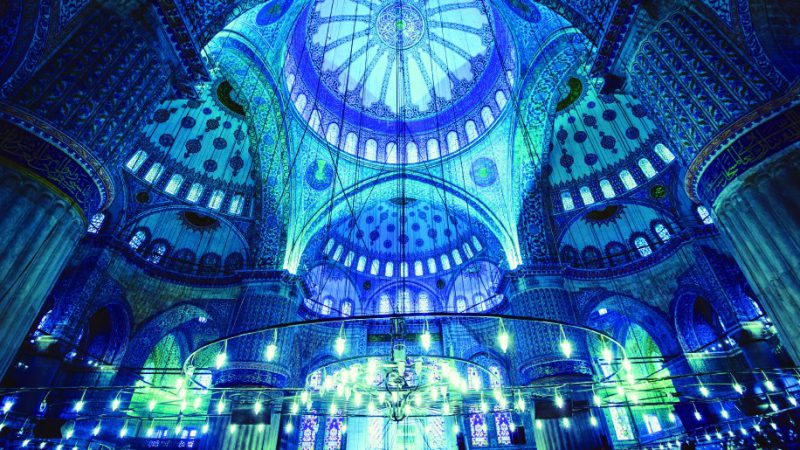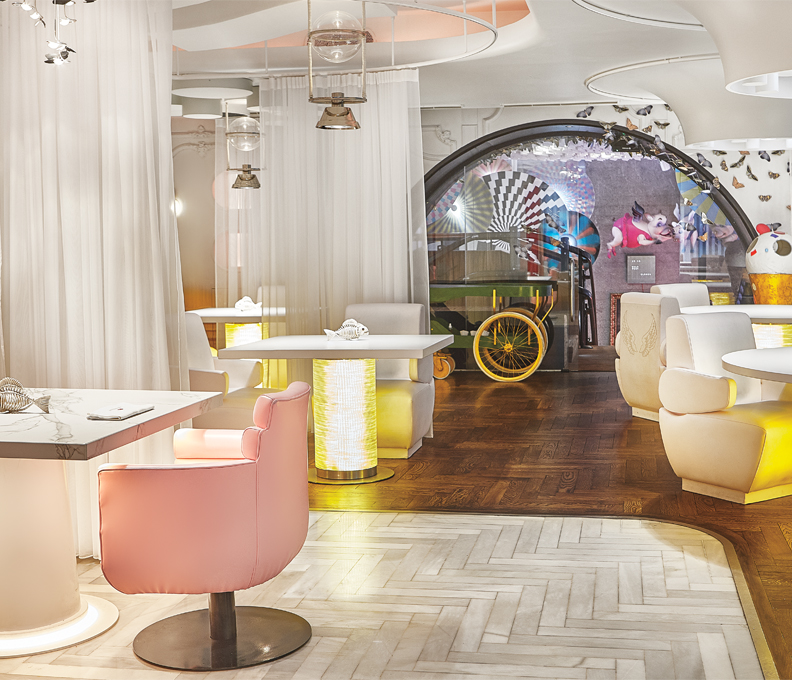Turkish Delight
From the eerie silence of the Basilica Cistern to the city’s cacophonous celebrations, Istanbul never fails to mesmerize
June 1, 2019

I’m heading back to my hotel after a spectacular Turkish feast at Ali Ocakbaşı Gümüşsuyu (a great little dining spot overlooking the Bosphorus) when out of nowhere, cars begin streaming past with their horns blaring. Passengers are hanging out the windows shouting, brandishing flags and setting off flares. The traffic lights ahead turn red; one car deliberately swings across all three lanes blocking the highway. Four young men leap out and jump on the roof, chanting at the beeping vehicles behind them and setting off more flares. I’m genuinely quite alarmed – what is going on? An uprising, a protest, a political rally?
As it turns out, it’s a football victory. It’s the end of the Super Lig – the Turkish Premier League. Galatasaray has beaten Goztepe in a tense 1-0 showdown to win the cup, and half the city has erupted in celebration. We crawl past Taksim Square – the central piazza in the heart of “modern” Istanbul – where throngs of jubilant fans have congregated to join the revelry. The riotous celebrations last until the early hours, as evidenced by the continuous hooting outside my hotel room.
It’s the complete opposite of my first impression of Istanbul, when I landed almost 48 hours earlier. The drive into the city revealed a peaceful cityscape emerging through a hazy sunrise, a pink wash of ancient buildings dotted with minarets standing astride the peninsula that juts out into the Bosphorus Strait.
A 20-minute drive took us through Constantinople, the ancient capital, and over a large estuary known as the Golden Horn into Beyoglu district, the “European side” formerly known as Pera. Here, much of the architecture dates back to the 1800s, when European merchants created grand embassies, stately homes and posh boutiques. Today, it’s the art, entertainment and nightlife center of Istanbul.
Our destination is the Pera Palace Hotel, the oldest international hotel in the city, set on a charming, winding hillside. It was built in 1892 to offer refined lodgings to passengers of the Orient Express – the legendary train of luxury and intrigue that linked the great capitals of Paris and Constantinople. The 126-year-old grande dame has lost none of her pizzazz: The entrance boasts a lavish display of rich marbles and luxurious furnishings. An irresistible urge to peek into the chamber beyond reveals an enormous double-story Rococo lounge – the Kubbeli Saloon – extending back past a grand piano, library, bar area and onto an alfresco patio. I can easily picture illustrious guests like Ernest Hemingway and Alfred Hitchcock meeting over whisky and cigars.
New arrivals are given a special treat – a lift in Europe’s oldest working elevator. The antique carriage sits majestically in wrought-iron framework, gracefully rising five stories through the heart of a grand circular staircase.
Inside Room 411, you’ll find a tribute to one of the hotel’s most famous guests, the doyenne of British crime fiction, Agatha Christie. It is believed she wrote her 1932 classic novel Murder on the Orient Express during one of her stays, and this room now features a library of Christie’s novels, a working typewriter and historical memorabilia dedicated to the murder-mystery maven.
On the ground floor, Room 101 reveals a reverent museum exhibition dedicated to modern Turkey’s founding father, Mustafa Ataturk. The revolutionary army officer served as prime minister from 1923 until his death in 1938, and is still a beloved national icon. The display offers an intimate glimpse into his life, with the clothes he wore, rich tapestries (said to have predicted his death) and notes from his work and continuous studying – which extended right up until the day he died.
A Whirl Around the City
There are plenty more fascinating historical nuggets to unearth in this evocative property, but it’s time for brunch. We meet our guide Ozlem at a local market; I can’t help but do a double-take – with her peroxide-blonde hair, large brown eyes and red-lipped smile, she’s the spitting image of singer Gwen Stefani.
After stocking up for our impending traditional breakfast, we head back to her apartment where she offers us slippers and douses our hands in perfume – a customary greeting. We make ourselves at home while Ozlem chats away, as she whips up what turns into an incredible feast: menemen (roast peppers stewed in a fragrant tomato sauce); borek (flaky Turkish pastry filled with various savory flavors) and kaymak (clotted buffalo milk drizzled with honey). Add in a mountain of figs and mulberries, breads, olives, cheeses and hams, and wash it down with strong black tea and rich coffee – we can’t get enough of it.
Fueled for the afternoon, we head out to see some of the surrounding sights. In the center of Beyoglu is the soaring Galata Tower, a Romanesque structure built in the 14th century. The Medieval watchtower offers incredible 360-degree views over Istanbul, the Bosphorus and the Golden Horn. Expect lines, with just two elevators whisking tourists to the top-floor restaurant, followed by three flights of stairs leading to the circular viewing platform (entrance 25 lira/$4; open 9:00 AM – 8:30 PM).
From Galata Tower it’s just a short walk to join the elegant pedestrianized thoroughfare known as Istiklal Street (Independence Street). Vintage trams rumble along the one-mile avenue lined with shops, galleries, cinemas, pubs, patisseries, churches, historical passages and more, eventually culminating in Taksim Square, featuring the Republic Monument.
Later we head across the water to the circular, stone Hodjapasha theatre, remodeled from a 15th-century bathhouse. There’s a sombre atmosphere as the white-robed Whirling Dervishes and accompanying Sufi musicians walk on, with a projected sign instructing the audience not to applaud the sacred sama ceremony they are about to witness.
What follows is a hypnotic ritual of whirling, wailing and willing your eyes to stay open. The rhythmic beating of the benedir (frame drum), monotonous keening of the neys (flute-like instruments) and dizzying spins of the dervishes send more than a few audience members nodding off – but it’s a cultural experience that stays with you. (Shows start at 7:00 PM daily; cost $20. It’s worth arriving a little early to digest the extensive exhibition that offers a background to the Whirling Dervishes and the ritual performed.)
Spectacular & Spine-Tingling
The next day, we get up early to tackle some of Istanbul’s most famous historic sights: the Hippodrome of Constantinople, Sultan Ahmet Mosque (popularly known as the Blue Mosque), Topkapi Palace, Hagia Sophia and the Basilica Cistern, all handily located within walking distance of one another – each one more awe-inspiring than the last.
Start at the Hippodrome, the site of an ancient Byzantium chariot-racing stadium peppered with monuments including the 3,500-year-old ancient Egyptian obelisk of Thutmose III and the bronze Serpent Column, relocated here by Constantine the Great in 324 AD.
Move swiftly on to the Sultan Ahmet (Blue) Mosque, built in the 17th century with an ostentatious six minarets that courted controversy at the time for competing with the Grand Mosque in Mecca – the only other mosque to boast six minarets at that time. (Sultan Ahmet ended the controversy by adding a seventh minaret to the Grand Mosque structure.)
With 30,000 visitors a day, the trick is to get ahead of the crowds. Doors open at 8:30 AM with little or no queue for early birds. A strict dress code is enforced as the temple is still actively used for prayer, though the cartoon diagrams are genuinely confusing. Basically, keep your arms and legs covered, no tight jeans, and ladies cover your hair – nearby stalls offer robes and scarves to borrow. (Entry is free; open 8:30 AM – 6:00 PM every day, excluding prayer times; sultanahmetcamii.org)
From the exit it’s straight on through the rose gardens and turreted gates into Topkapi Palace, a sprawling palace-cum-museum. Here you’ll discover the original residence of the Ottoman sultans and incredible collections of artifacts: A stunning clock-filled room with an array of timepieces, and a fearsome antique weapons horde. The sacred relics room features the renowned staff of Moses and revered scrolls from Mohammed, while next door a hafiz (someone who has memorized the Qur’an) recites the verses into a microphone.
Head onwards to one of the most magnificent buildings in the world. This is no exaggeration – the staggering proportions of the Hagia Sofia alone are mind-blowing. The main dome looms 182 feet overhead, resting on an arcade of 40 arched windows and columns.
The incredible feat of engineering is accompanied by ornate interiors featuring a mixture of Christian frescoes and Islamic calligraphic panes, a reminder that the place has been witness to centuries of history. Alas, there are long-term, large-scale restoration works in progress, but there is plenty of beauty to go around. (Entry 40 lira/$6; open 9:00 AM – 7:00 PM until October 30, closes 5:00 PM in winter).
Our final stop, an unassuming entrance hides a deeply atmospheric, chilling subterranean reservoir. Particularly spine tingling, in my case, due to an overwhelming sense of déja vu; I recognize this cavernous chamber with its perfectly aligned glowing columns and still, dark pools. Unbidden, an image of Tom Hanks flashes into my mind, and it clicks: this was the setting for the dramatic finale of Inferno, the 2016 movie adaptation of Dan Brown’s eponymous novel.
A 10-minute walk along the boardwalks brings you to the remnants of a Medusa head, and thrashing pools of sickly colored carp. The Basilica Cistern was built by Justinian I in 532 AD as the largest of the underground tanks that stored the city’s water supply. To protect citizens from being poisoned by foreign enemies, the fish were installed like canaries in a coal mine: if the water was tainted, the fish would die.
At this point, my step count is pushing 20,000 and time is ticking. But missing out on shopping in Istanbul is not an option. For time-pressed visitors, the Spice Bazaar is a large, covered shopping mall offering a condensed version of Istanbul’s favorite goodies and souvenirs, but if you have time, it would be a sin not to experience the Grand Bazaar.
The ancient marketplace is immortalized in action movies from Skyfall to Taken 2. But nothing can prepare you for the vast network of ancient columns that make the Grand Bazaar grand. The goods here range from leather, fashion and handbags to Willy Wonka-esque Turkish Delight shops and racks of spices that’ll have even the laziest cooks itching to purchase. Next door you can stock up on beautiful crockery and silver coffee sets to go with all those new recipes you’ll be doing.
My final evening is utterly spectacular: a Bosphorus cruise with dinner aboard a sleek white yacht. Staff materialize from the galley with bottles of beer and glasses of Prosecco, while we enjoy music on the top deck and magnificent waterfront sights unseen by land-based tourists, including the Dolmabahce Palace and Kuleli Military High School. We head downstairs for a magnificent spread of Turkish meze, salad and fresh fish as the sun begins to set; the perfect counterpoint to the start of my mesmerizing visit to Istanbul.




